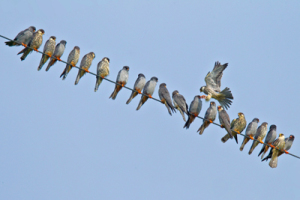Nagaland
Amur falcon: Lone satellite-tagged survivor on its way to Nagaland

Eastern Mirror Desk
Dimapur, Oct. 17: Out of the eight amur falcons that were tagged with satellite transmitters, the lone surviving ‘winged guest’ by the name ‘Longleng’ is on its way to Nagaland, according to an official.
The wildlife warden in Dimapur, Caroline K Angami, and district forest officer in Wokha, Zuthunglo Patton, had earlier confirmed the arrival of the first flock of amur falcons in the state with several of them sighted around Barak valley in Peren last week. It is informed that the actual migration will take place in the first week of November.
Chief Wildlife Warden, Nagaland, Satya Prakash Tripathi told Eastern Mirror over telephone that ‘Longleng,’ the only surviving amur falcons tagged with satellite transmitter, is nearby Nagaland.
“Sometimes we cannot trace where the birds are, and sometimes the transmitters do not function properly so we do not get any information regarding the rest of the birds. There is a possibility that the birds might have died or maybe, our transmitters are not functioning,” he said while adding that this bird generally has a lifespan of two to three years.
It may be mentioned that in November 2013, a team of scientists from the Ministry of Environment and Forests, Wildlife Institute of India, Convention on Migratory Species Office, United Nations Environment Programme and Environment Agency, and Nagaland Forest department along with Pangti villagers undertook a joint scientific mission to satellite-tag the Amur Falcons in Nagaland at Doyang in Wokha.
The mission was conducted in two phases, one in Nov. 2013 and the other in Nov. 2016. In the first phase, three birds named ‘Naga,’ ‘Wokha,’ and ‘Pangti’ were fitted with the state-of-the-art five gram solar-powered PTT-like backpack using a specially made teflon harness. It was released in the morning of Nov. 6, 2013. This placed Nagaland in the international map of ‘global conservation.’
All the birds were ringed with a metal ring on the left leg and a colour-coded plastic ring on the right. ‘Naga’ and ‘Pangti’ were tracked for a record duration of 1,117 and 880 days respectively.
In the second phase that took place in Nov. 2016, a total of five birds named ‘Hakhizhe,’ ‘Intanki,’ ‘Longleng,’ ‘Eninum,’ and ‘Phom’ were tagged. It was funded by the ministry of Environment, Forest, and Climate Change after the success of the first phase.
Meanwhile, Tripathi informed that the birds will not be tagged in Nagaland this year but will be done in Manipur where the birds also visit. He said that specific location of the avian could not be intercepted as he was on leave and assured to provide more details through the officials of Wildlife Institute of India, Dehradun when he joins his office.

